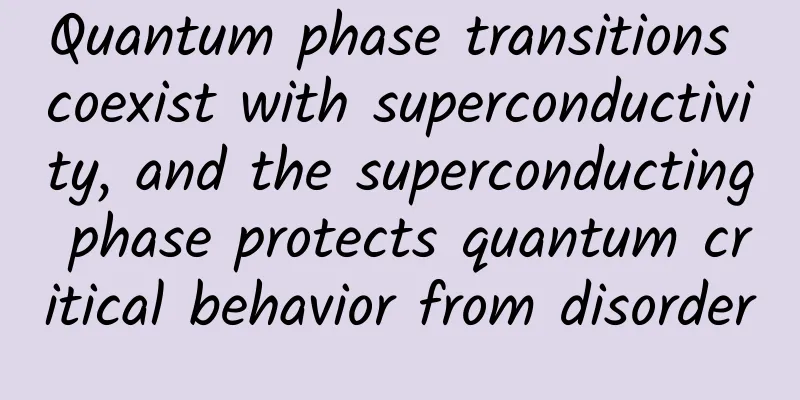Quantum phase transitions coexist with superconductivity, and the superconducting phase protects quantum critical behavior from disorder

|
[Mobile software: Bo Ke Yuan] Physicists at Ames Laboratory have successfully made measurements of an iron-based superconductor in an important but hard-to-reach region where critical quantum fluctuations dominate physical processes. Using a new sensing technique, the researchers accurately mapped quantum phase transitions deep within the superconducting state, a phenomenon that is theorized to be tightly coupled to superconductivity. This innovative experimental setup, called a nitrogen-vacancy (NV) magnetic mirror, is highly sensitive, virtually non-invasive, and more precise than previous experimental setups used to explore similar physics in superconducting materials. This is a truly fascinating result in superconductor science: a clear understanding of how quantum phase transitions coexist with superconductivity. "It seems that the superconducting phase protects the quantum critical behavior from disorder, which is quite remarkable! As we continue to study other materials with this new capability, this will help answer important theoretical questions about the origins of unconventional superconductivity," said Prozorov, a physicist at Ames Laboratory. The research team used NV probes to precisely measure the London penetration depth, or the depth to which a magnetic field penetrates from the surface of a superconductor into the superconductor. Their study was published in the journal New Physics. This depth is directly related to the effective electron mass, a quantity affected by quantum fluctuations that signals the presence of a quantum phase transition. By systematically measuring different compositions of the iron peptide compound Ba(Fe,Co)2As2 grown by Paul Canfield's group at Ames Laboratory, the team could map out the presence of quantum phase transitions that are normally hidden under the superconducting "dome" as temperatures approach absolute zero. Prozorov leads a team of scientists at Ames Laboratory's cryogenic laboratory to study the intriguing behavior of superconductors and try to unravel how various quantum phenomena affect their properties. The researchers developed unique ultra-high precision and ultra-sensitive experimental techniques specifically to measure the optical, magnetic and electrical signatures of these behaviors. The NV detector was built from scratch by Ames Laboratory scientist Naufer Nusran and graduate student Kamal Joshi, an optical magnetometer that exploits the quantum state of a special type of atomic defect in diamond, called a nitrogen-vacancy (NV) center. Nusran also designed a novel method to use NV centers to measure the lower critical field that leads to the London penetration depth, one of the most fundamental parameters for describing superconductors. Essentially telling us how stable a superconductor is, NV sensing represents a major advance in experimental superconductivity. The Prozorov lab is part of an international research collaboration that has found the first clear evidence that a quantum critical point (QCP) survives deep in the superconducting state. The current study shows this using new methods, examining superconducting systems with large amounts of disorder. Taken together, these studies demonstrate that quantum phase transitions and critical fluctuations not only coexist with superconductivity, but may even be protected by it from disorder effects. This result is another important clue to unlocking the mystery of iron-based superconductors, however, there is still much work to be done to fully explore the science of unconventional superconductors. To do this, newer and more sophisticated quantum sensing methods must be developed. New quantum sensing methods can detect quantum fluctuations at the nanoscale, which will enable deeper research into competing and coexisting quantum phases in high-temperature superconductors and many other materials science problems. These novel capabilities will ultimately reveal the limiting conditions and feasibility of superconductors and other quantum materials in technological applications. Bo Ke Yuan | Research/From: Ames Laboratory The research was published in the journal New Physics BoKeYuan|Science, technology, research, popular science |
>>: Silverware is loved by many people, what is its charm?
Recommend
Zhulu Video Account 1.1 Operator Practical Operation Course New Platform New Opportunities, Build a Private Domain Traffic Position!
Zhulu Video Account 1.1 Operator Practical Operat...
KFC's "Family Bucket" Marketing Strategy
KFC’s marketing approach has always been wild. Th...
Knowing these things, fish will taste even better!
Foodie Cloud: Those who run on the ground are not...
Planting trees at an altitude of 3,600 meters, the barren mountains are turning green!
"Gelsang flowers are in bloom, trees are lus...
The first generation iPhone sold at a sky-high price. Outdated electronic products = garbage?
As we all know, the masterpieces left by masters ...
If you are losing weight, please keep this good news
Audit expert: Wu Xi Deputy Chief Physician, Depar...
TV remote control is not easy to use? Then you have to try the far-field voice recognition function of the Redmi X series
With the frequent participation of smartphone man...
The O2O showdown between Dianping and Meituan: Platform vs. self-operated
Dianping and Meituan, which started out as mercha...
How to increase the number of followers by 30,000 in one month without any hot spots?
The Double Eleven shopping carnival has passed, a...
How to make online brand promotion strategy “heartfelt”?
The company's corresponding promotion strateg...
Painting Story | Over the years, humans have had misunderstandings about rabbits...
Rabbits are so cute, how can you not know their l...
New plant species discovered in Medog, Tibet!
Recently, researchers discovered a new species of...
The "magic weight loss drug" can actually support an entire country. Do you know what the success rate of weight loss is?
The magic weight loss drug supports a country: in...
Should I be overly concerned about my iPhone's battery health? Not necessarily.
In the early days when Nokia was popular or when ...









